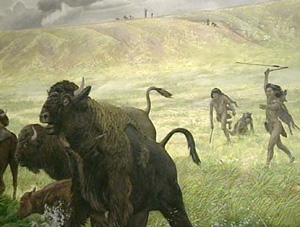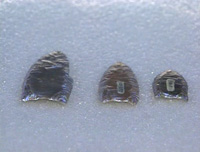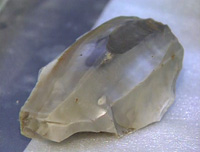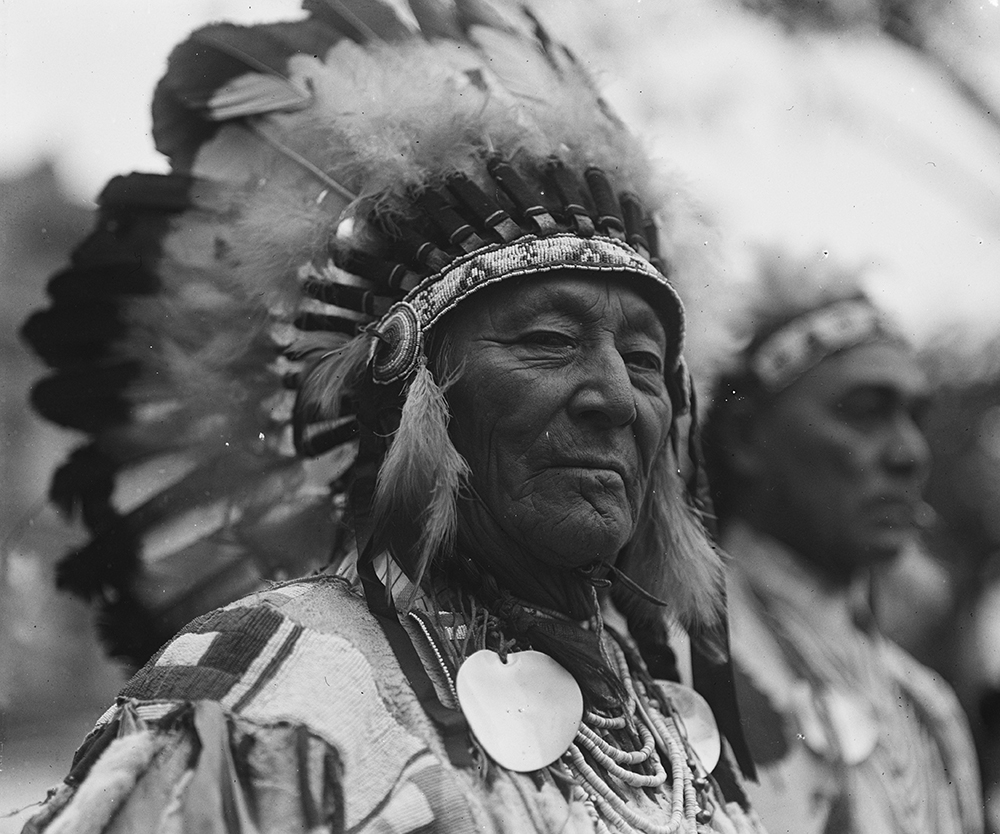The first Texans were nomadic hunters. Between approximately 12,000 to 8,000 years ago, small bands of hunters were living in Texas. These Paleoindians, known as the Folsom, Clovis, and Plainview cultures from the places in Texas and New Mexico where their sites were first found, shared a number of characteristics. They made weapon points, scrapers, and knives, used fire, hunted in groups, and used the spear or atlatl as their principal weapon.




Thomas Hester (Director, Texas Archaeological Resources Laboratory, UT-Austin): “The earliest hunters such as the Clovis or Folsom, had a tool kit that consisted of primarily chipped stone, that is they used large blocks of flint from which they made cores, and off of these cores they took large flakes or blades from which they made their spear points, which for the Clovis people we call Clovis points, and for the Folsom people we call Folsom points. These were the spear tips that they used in hunting. They also made knives and scrapers out of flint. They probably also had bone tools and wooden tools that they used. Men are the hunters, and the women and children do a lot of the basic food collecting and gathering of plant foods and small game, and do a lot of the processing of these foodstuffs and processing of hides. Hunters and gatherers planned their schedules, they know where they’re going to be, they know what they’re going to do. So they schedule their whole year or their season to season movements based on where the plants and animals and other resources are going to be.”
Regarding the Native American Rock Art of the Lower Pecos River Region in West Texas
Thomas Hester: “Some archaeologists look at the Lower Pecos rock art that depicts figures that are human and often have deer associated with them or panthers associated with them as hunting magic art that was done to guarantee the success of the hunt, or that the panther was a rival to the humans. Other people look at them and see them as shaman figures or medicine men, and their regalia, and that the deer and the antlers and so forth are all part of the medicine man’s gear that he would use. Other people look at them as shamans who are in the process of transforming themselves from humans into animals, which is a phenomenon that we see around the world, a lot of cultures have medicine men who claim that they can transform themselves into other kinds of animals.”
The Archaic cultures dominated Texas until sometime between 500 and 1000 AD, when new cultural influences produced the Indian groups that the Europeans encountered in the 16th century. In the early 1500s, the people inhabiting the region of present-day Texas belonged to numerous bands or tribes, many of which spoke unrelated languages and lived in very different ways. Generally, they can be categorized into three major culture types: Coastal Hunter/Gatherers, Farmers, and Plains Hunters.
Watch a sample video clip from our documentary
The Settlement Of Texas, Part One: The Native Americans
Regarding the Plains Hunters
Wallace Coffey (Chairman, Comanche Tribe): “About the 1680s, when our Comanche people began to look to the buffalo as a way of life, we became a horse culture after the acquisition of the horse, the maneuverability, the ability to travel from one location to another, it became an economic resource. We became very functional with regards to the Southern Plains, the areas of Oklahoma and Texas were very conducive to our standard of living, and by all means the buffalo was one of the main purposes with regards to the relationship that we had with the Southern Plains. So we were very adept in warfare, we were probably some of the greatest hunters on horseback, and to this day we have a reputation that our ancestors established for us as the Lords of the Plains.”
Towana Spivey (Director, Fort Sill Museum, OK): “The Kiowas were buffalo hunters, as were the Plains Apaches, they lived a nomadic lifestyle, they moved around, lived in teepees, depended heavily upon the buffalo, were gatherers as well from the products of the land that they could find, but buffalo by far were their main stay of their diet, and the buffalo also provided for their housing, weapons, clothing, and various other things. Some of the tribes, the Kiowas for example, had feelings about eating fish. They would not eat something out of the water. As a general rule some of the tribes would not eat birds that flew up, such as a grouse or prairie chicken, they considered them cowards. So these tribes see themselves as the center of the universe, which is supported by nature around them. The plants, the animals, everything has some spiritual connotation or involvement. In some instances, there are taboos, such as among the Kiowas, where you cannot kill or eat bear.”
Regarding the Native American legacy today
Towana Spivey: “We have a very interesting situation in our modern society today regarding Native Americans. Native Americans have been officially and legally recognized as being sovereign nations within this United States of America. On the one hand, they are Americans like everyone else. They are Native American. On the other hand, they are independent nations and they have their own leadership. They have their own cultural values. Their efforts to retain those cultural values is an ongoing dilemma for the tribes, how to live in two worlds at the same time, a very difficult situation. They work Monday through Friday at normal, everyday jobs like other non-Indians do, but they go home in the evenings and on weekends to another culture, another society, where values are different, a close knit family, where views of family, of property ownership, are different than non-Indians. It does cause some individuals within certain tribes a lot of difficulty and they have some problems adjusting to this dual identity. Others have learned to adapt and to find their place in the world as Native Americans first, and secondly, as Americans.”
We hope you enjoyed these excerpts from our Texas History documentary The Settlement of Texas-Part One: The Native Americans.

